70 pictures detail the "Ten Sins" of Brother Ma Ji, Huang Li Cheng in the cryptocurrency world
Written by: zachxbt
Compiled by: Paimon, ForesightNews
Jeffrey Huang, known as Machi Big Brother among netizens, is a former American-Taiwanese musician and tech entrepreneur. In 2018, he misappropriated 22,000 ETH from Formosa Financial and subsequently launched more than a dozen failed token and NFT projects over the next four years after its collapse. This article will introduce Jeffrey Huang's many "dark histories" in the cryptocurrency field, including an overview of Formosa and his subsequent projects along with other participants, as well as other factual evidence.
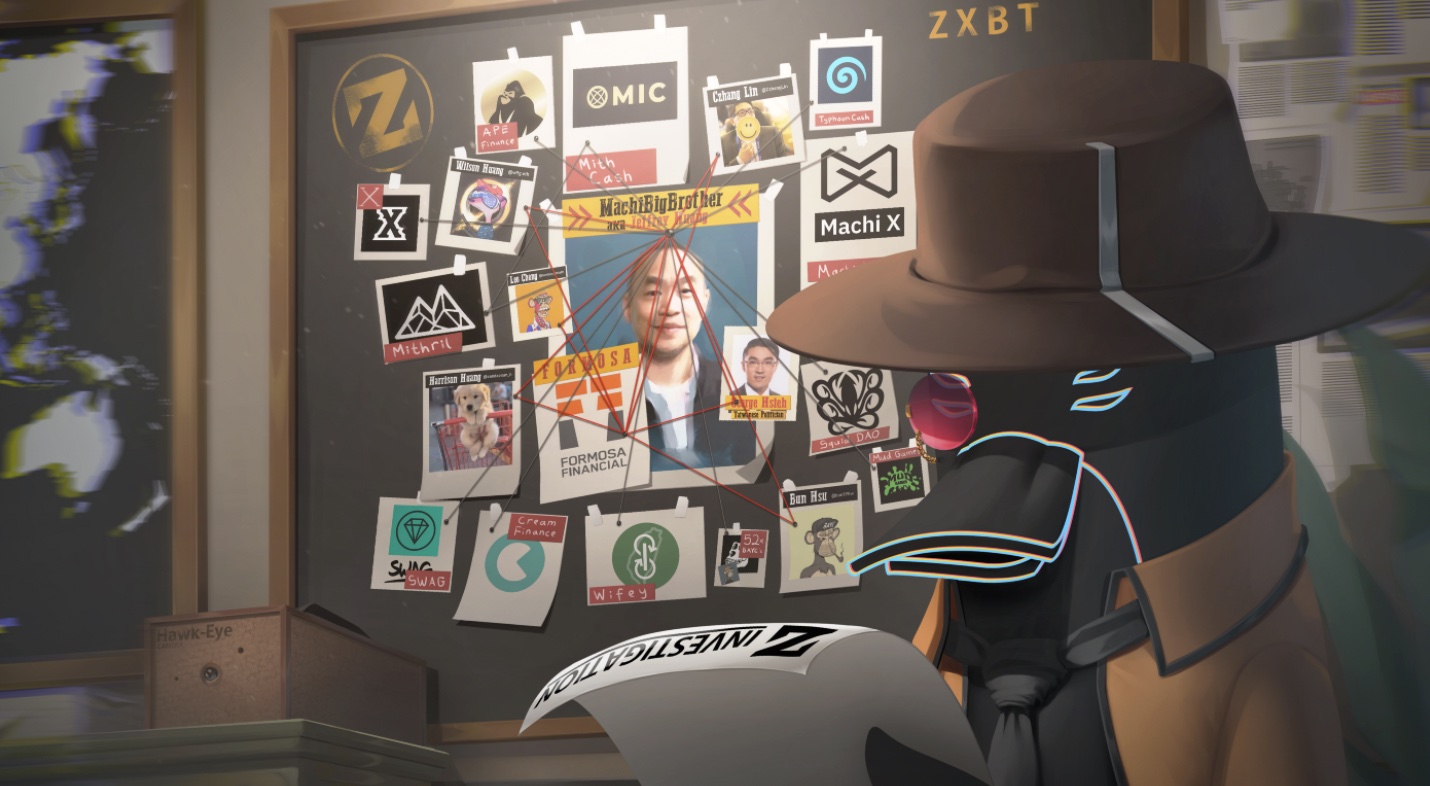
In the past year, "Machi Big Brother" (also known as Jeff Huang), as one of the largest BAYC holders, has made a name for himself in the NFT space. That said, few people know about his "dark history" in the cryptocurrency field…
Background
Jeffrey Huang, also known as "Michi Big Brother," is an American-Taiwanese musician and tech entrepreneur residing in Taiwan. Huang first gained attention as a founding member of the pop/rap trio L.A. Boyz, which was formed in 1991. L.A. Boyz was active from the early to late 90s, releasing 13 albums and gaining increasing recognition in Asia before disbanding in 1997.
After the success of L.A. Boyz, Huang formed the hip-hop group MACHI in 2003, seizing the opportunity to make more money. Subsequently, Huang and his friends established a multi-faceted Asian hip-hop/rap record company named MACHI, which was under Warner Music. Eventually, Huang transitioned from the music industry to the tech field, founding 17 Media (M17) in 2015, which gradually became one of the most popular live streaming applications in Asia.
In 2017, Huang entered the cryptocurrency space through Mithril, marking the beginning of his involvement in launching "rug pull projects," where team members often exhibited questionable ethics and frequently engaged in pump-and-dump practices. The following sections will provide an in-depth introduction to these "rug pull" projects.
Project 1: Mithril
At the end of 2017, Huang founded the decentralized social media platform Mithril, aiming to directly reward content creators through its native token MITH. Mithril conducted a private token sale on February 21, 2018, raising $51.6 million (60,000 ETH), equivalent to 30% of the total token supply. 70% of these private sale tokens were unlocked in February 2018 during the TGE, with the remaining 30% planned to be unlocked over the next three months. In April 2018, Mithril was listed on the centralized exchange Bithumb. After the full unlocking of the tokens in May 2018, 89% of the circulating supply of MITH tokens was dumped, leading to a massive sell-off and subsequent collapse.

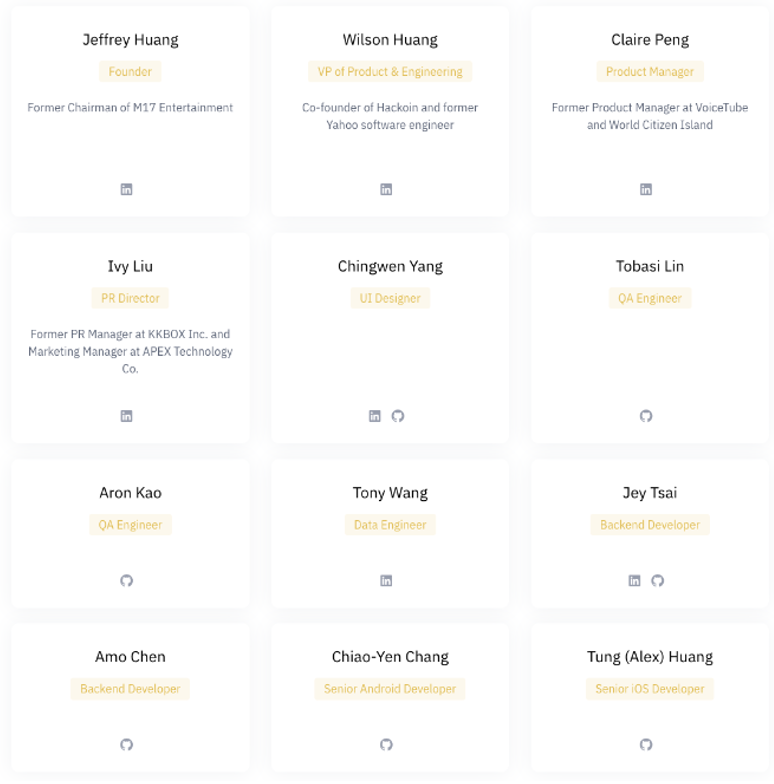
https://research.binance.com/en/projects/mithril
Project 2: Formosa
Going back to early 2018, Huang collaborated with Taiwanese politicians George Hsieh, Czhang Lin, and Ryan Terribilini to establish Formosa Financial, a financial management platform for blockchain companies. In the last week of April 2021, they completed an angel round financing totaling 22,000 ETH. Subsequently, on May 31, they raised another 22,000 ETH through a private placement, accounting for 30% of the total token supply. The two rounds of fundraising totaled $23 million (44,000 ETH). Notable investors included: Binance, QCP Capital, Lemnis Cap, Block One, Mithril / Huang (emphasized here), Maicoin, Wilson Huang, Leo Cheng's Syndicate, Blockstate, and Block One.
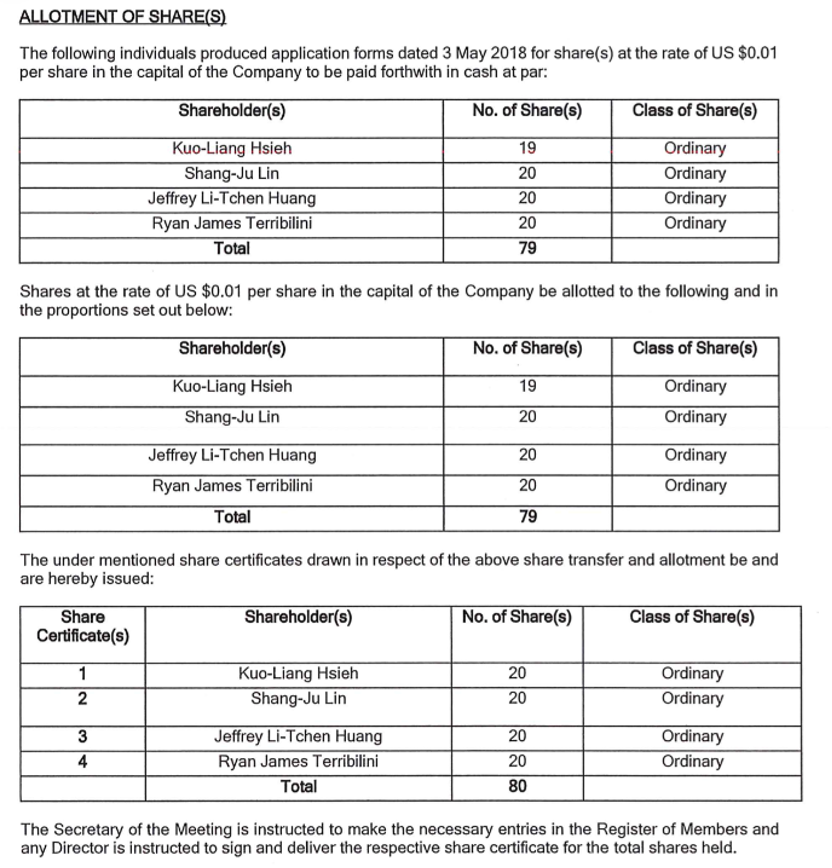
Stock allocation
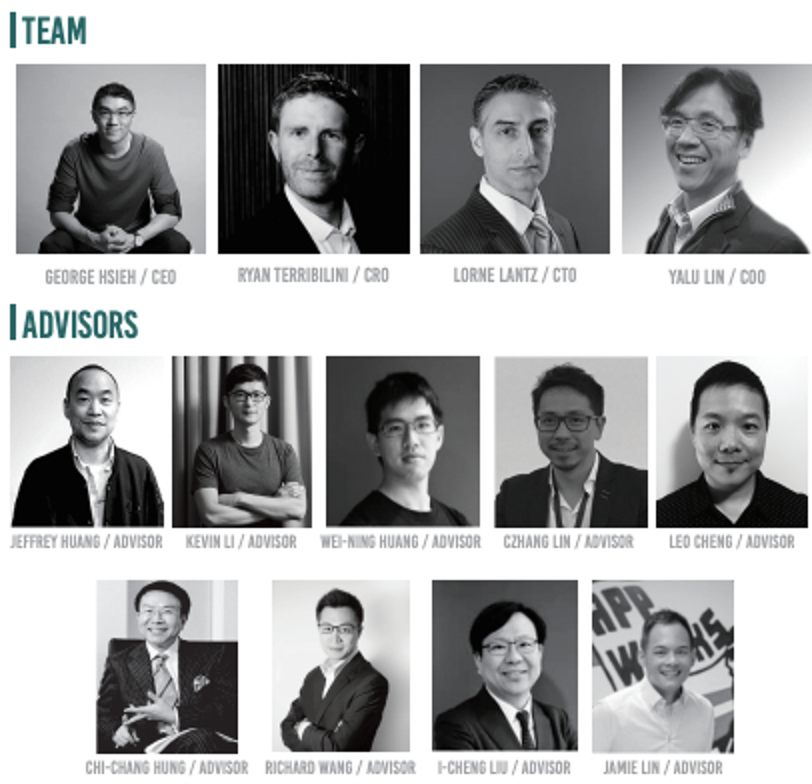
Formosa team
The team confidently assured investors that FMF was on a fast track to be listed on top CEXs.
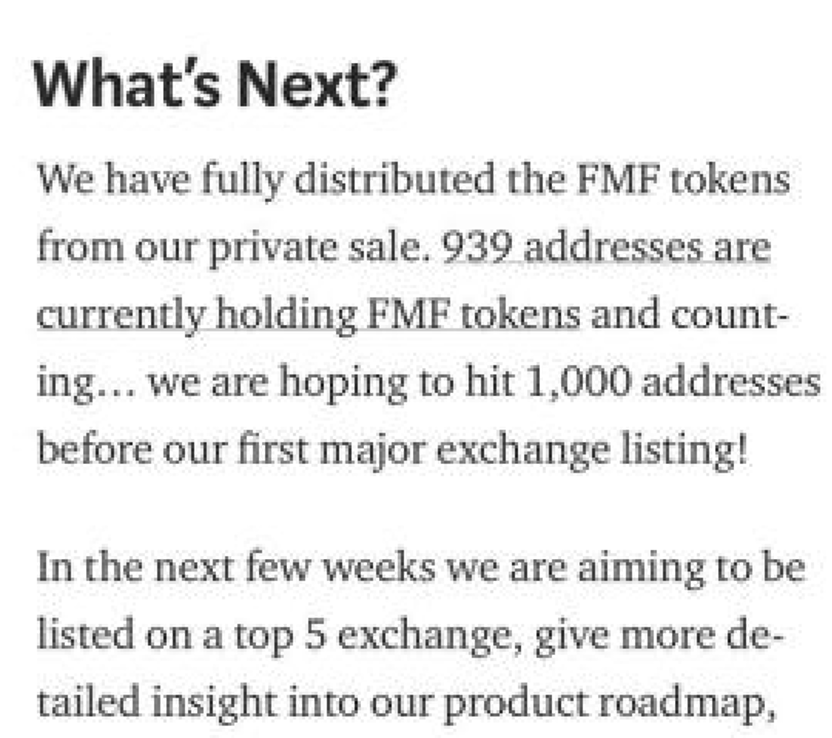
"What’s our next step?
All FMF tokens from our private sale have been allocated to users. Currently, there are 939 addresses holding FMF tokens, and this number is still increasing. We hope to reach 1,000 addresses before the first major exchange listing.
In the coming weeks, our goal is to list on five major exchanges and provide everyone with a more detailed understanding of our product roadmap."
------ Excerpt from a deleted media article
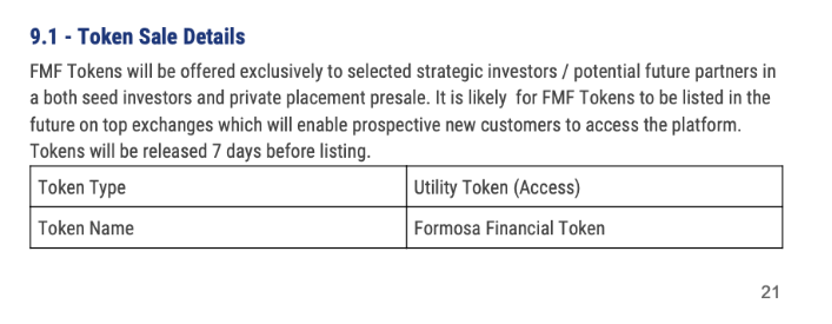 Excerpt from potential investor whitepaper
Excerpt from potential investor whitepaper
 Implication of listing on Binance
Implication of listing on Binance
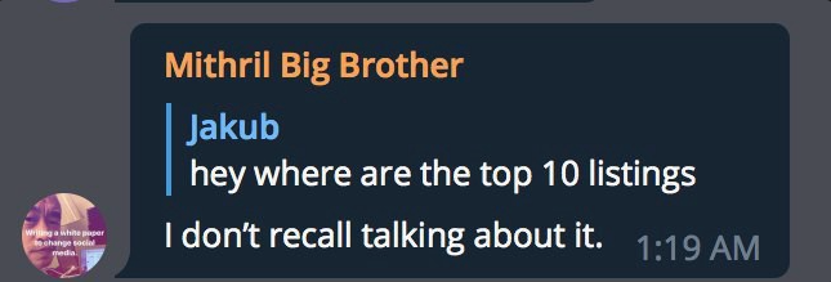 Machi later denied this
Machi later denied this
FMF was launched on IDEX in June 2018, and immediately plummeted after listing. It wasn't until September 2018 that it was listed on centralized exchanges (IDCM, UEX).
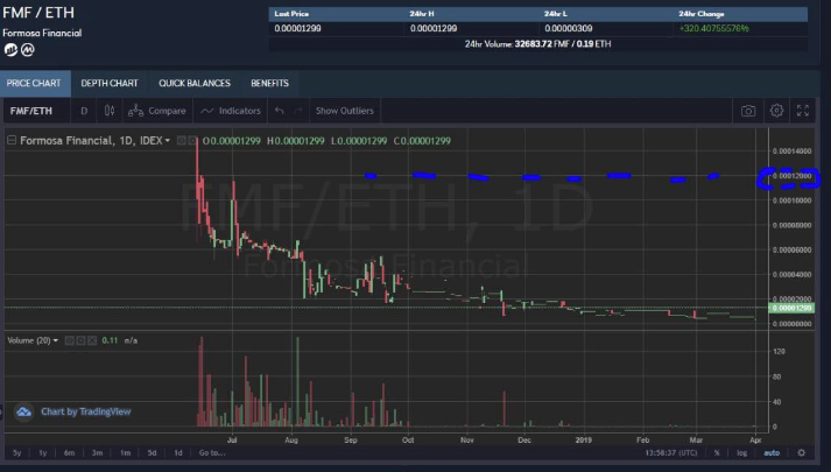 FMF trading on IDEX
FMF trading on IDEX
Additionally, 17 Media was scheduled to go public on the New York Stock Exchange on June 7, 2018, but due to undisclosed settlement issues with investors, the IPO was postponed after failing to raise $115 million. ZachXBT contacted an anonymous insider who revealed the underlying secrets: "M17's trading halt had little to do with its status as a private entity and regulatory restrictions or Citibank's operational errors. The failure should be attributed to M17's inability to meet audit and reporting requirements and its failure to overcome threshold bidding flaws, which meant that people could not adapt to this business model."
After the IPO failure, Huang expressed his frustration on Facebook and criticized Citibank and Deutsche Bank for their involvement in the IPO.

Just three weeks after the FMF ICO, the story of Formosa Financial took a rapid turn for the worse ------ two withdrawals of 11,000 ETH each appeared in its wallet. Co-founder George Hsieh, as the sole director of the company, privately sold his shares while keeping investors in the dark.
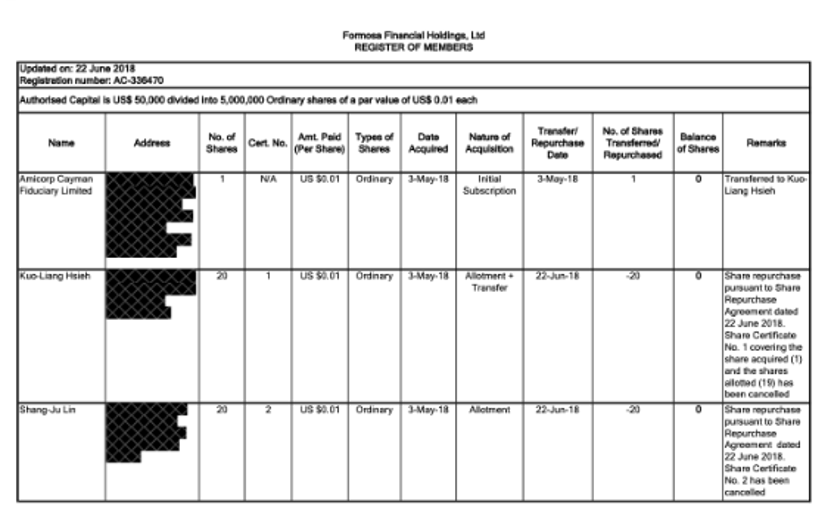
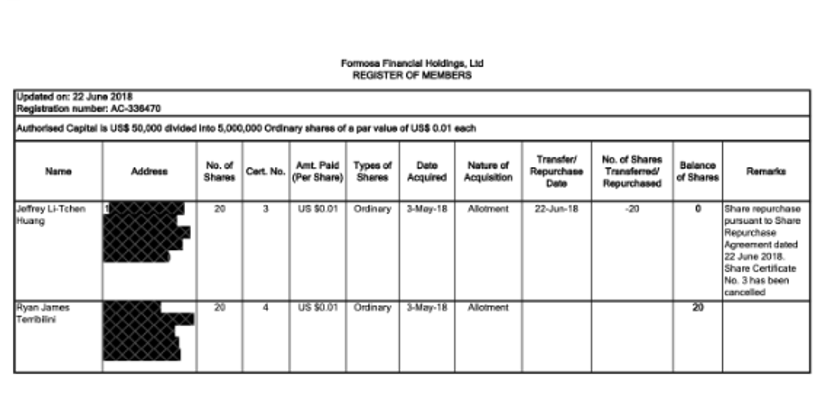 Stock buyback record from June 22, 2018
Stock buyback record from June 22, 2018
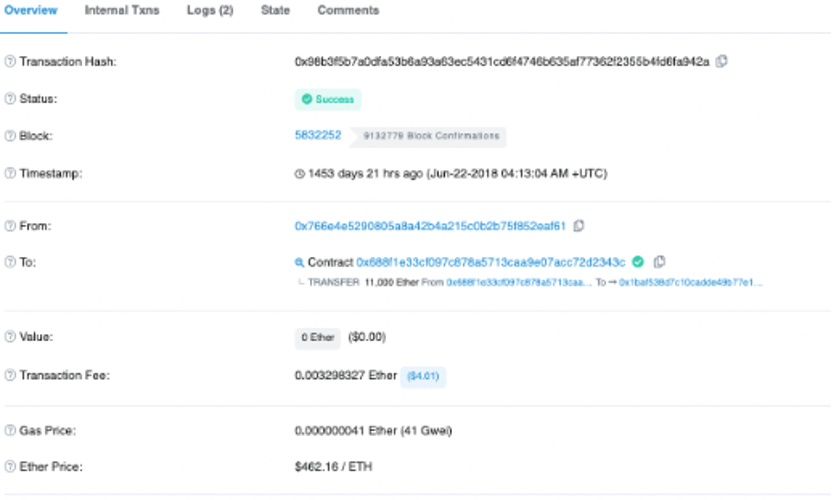
https://etherscan.io/tx/0x98b3f5b7a0dfa53b6a93a63ec5431cd6f4746b635af77362f2355b4fd6fa942a
Subsequently, George Hsieh, Jeffrey Huang, and Yalu Lin resigned, leaving co-founder Ryan Terribilini as CEO and Lorne Lantz as CTO.
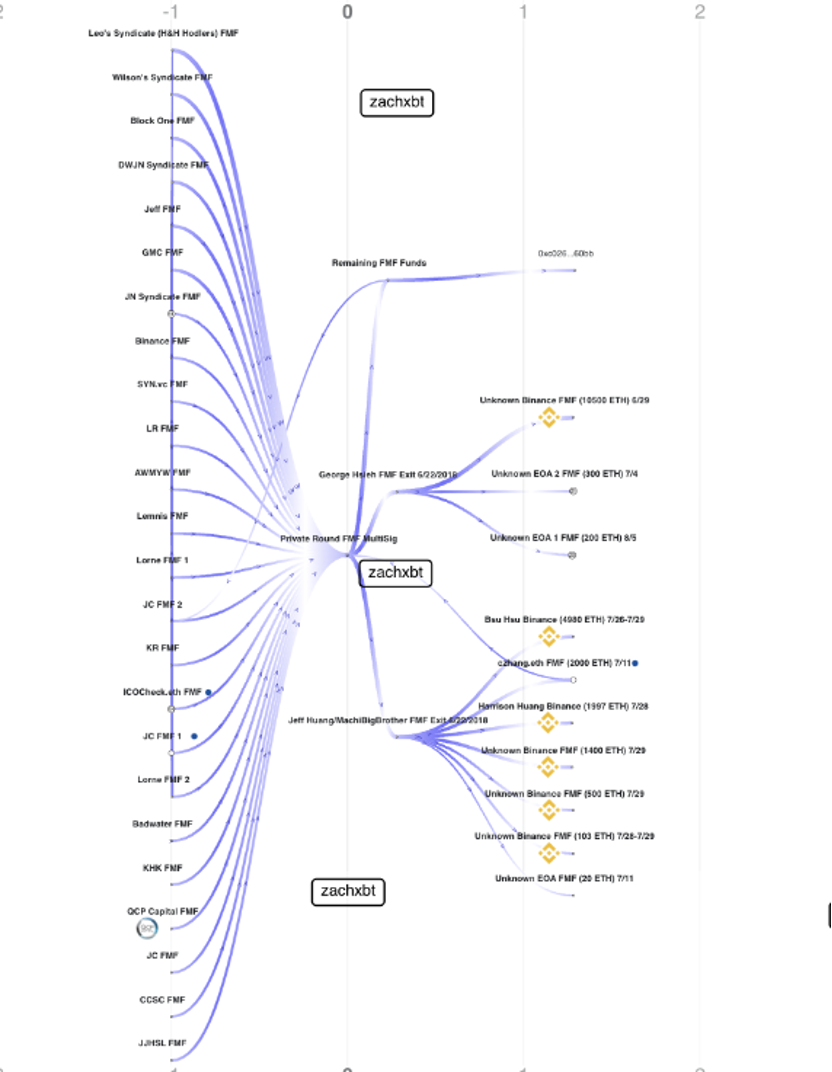
https://www.breadcrumbs.app/reports/1163
This chart shows the ETH flow into the angel and private placement funds before Huang and George withdrew 11,000 ETH each on June 22, 2018.
On June 29, 2018, George transferred 10,500 ETH to a Binance account. The KYC authenticity of this Binance account remains unclear.
As for Huang, his 11,000 ETH remained untouched in one wallet until late June and early July, when he transferred 4,980, 1,997, 1,400, 500, and 103 ETH to different Binance accounts. 2,000 ETH was transferred to czhang.eth, and 20 ETH was transferred to an EOA wallet.
The questions raised above remain unresolved. Regarding the ownership of these Binance accounts and wallets, let’s take a closer look at the flow of ETH:
- From July 26 to July 29, 2018, 4,980 ETH was transferred out. Records show that this Binance account had frequent funding sources from two origins ------ FTX and littlebang.eth.
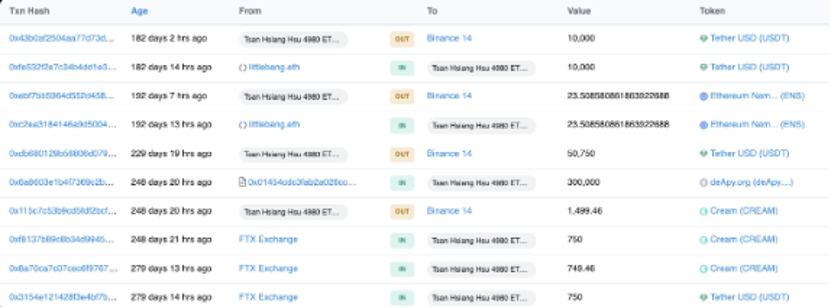
a) Searching for the owner of littlebang.eth on OpenSea reveals the username "Bun919tw."
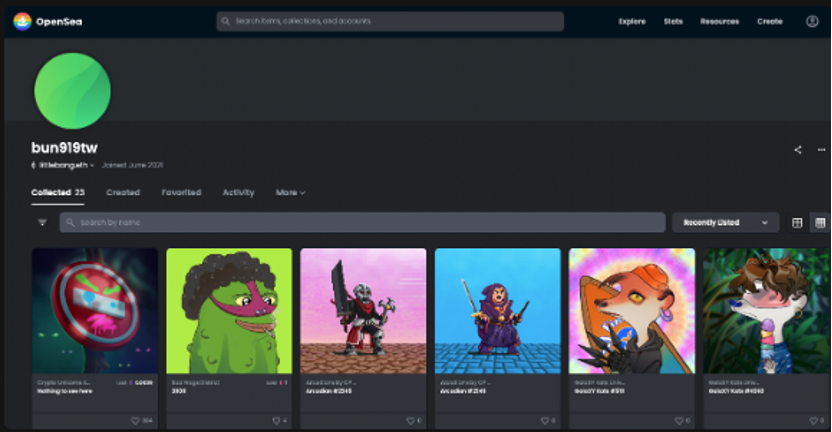
b) A quick Google search shows that "bun919tw" is actually Bun Hsu, a core engineer at Cream Finance, which happens to be another project of Jeffrey Huang.

https://medium.com/cream-finance/c-r-e-a-m-project-update-9d4fd484482f
c) Bun Hsu's Twitter avatar is BAYC #7066, which was gifted to him by machibigbrother.eth (Huang's public wallet).
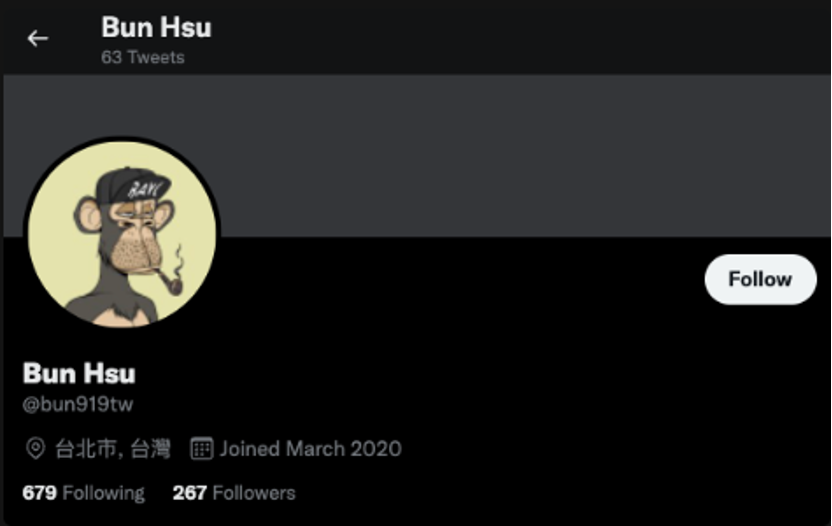
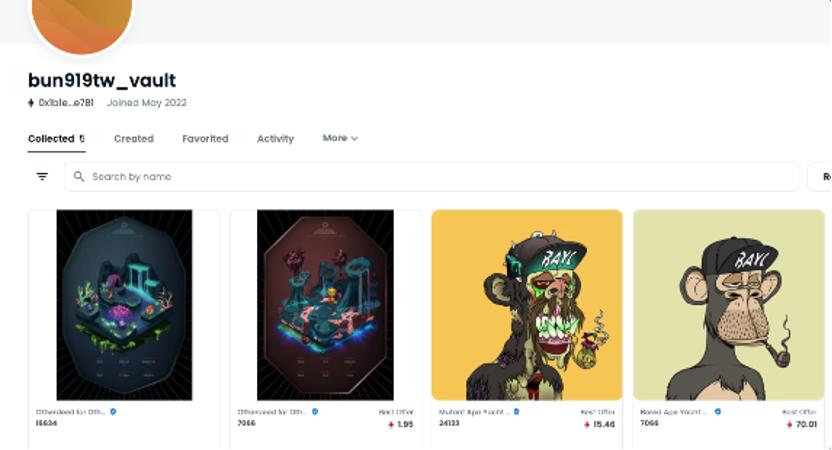
 https://opensea.io/assets/ethereum/0xbc4ca0eda7647a8ab7c2061c2e118a18a936f13d/7066
https://opensea.io/assets/ethereum/0xbc4ca0eda7647a8ab7c2061c2e118a18a936f13d/7066
d) Bun Hsu has had transactions with multiple projects under Huang, such as FMF, SWAG, CREAM, SQUID, PHOON, MCX, and MIS/MIC.
So why did someone not on the Formosa Financial team receive 4,980 ETH just three weeks after the ICO, and have "financial dealings" with Huang's projects and him personally?
- On-chain records show that 2,000 ETH transferred out on July 11, 2018, ultimately flowed to Czhang Lin (czhang.eth), who had been an advisor to Formosa Financial until June 22.
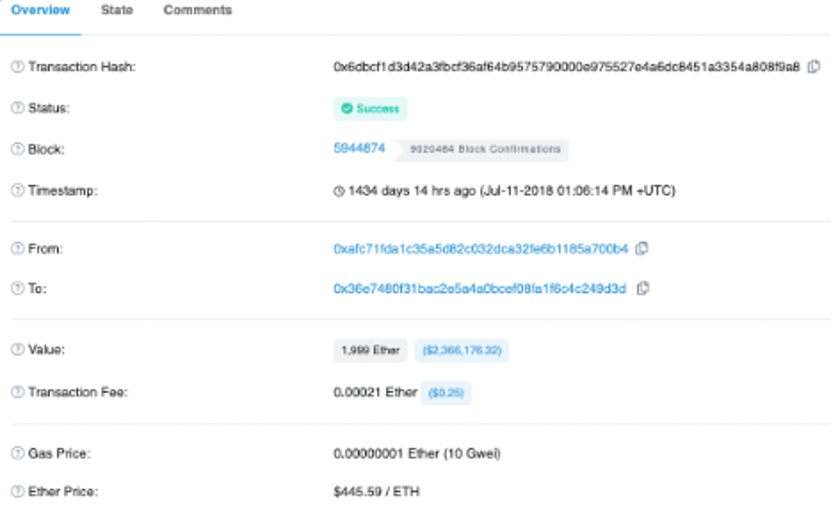
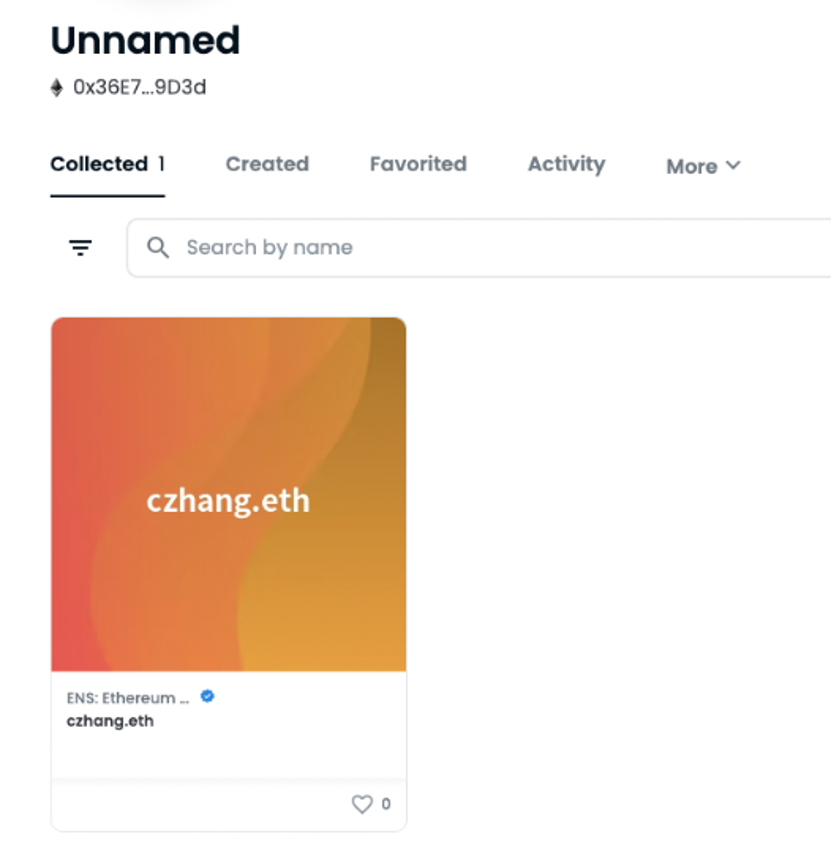
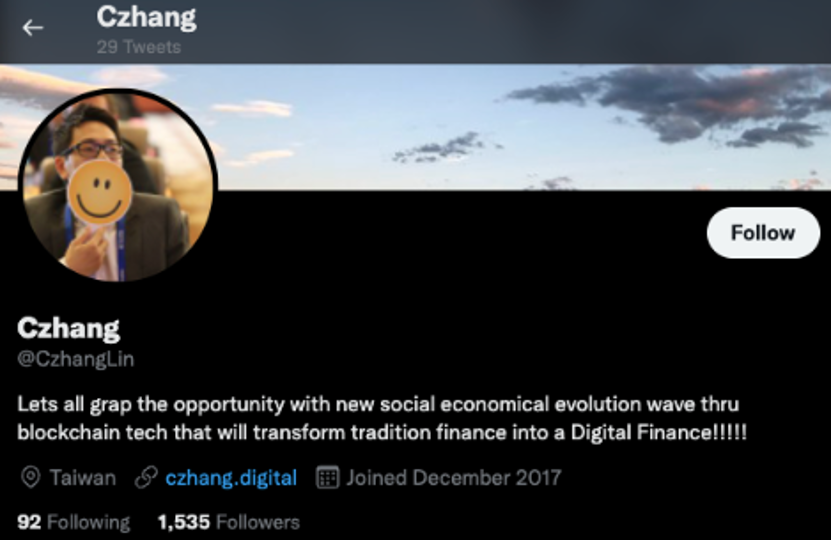
a) Three weeks after receiving 2,000 ETH, Czhang sent 150 ETH to his brother Yalu Lin (Formosa COO) on July 22, 2018.
Again, the similar question arises: why would an advisor and COO of Formosa Financial receive project construction funds?
- Regarding the 1,997 ETH that flowed out on July 28, 2018: the only income stream for this Binance account came from harrisonhuang.eth, which frequently interacted with w9g.eth (Wilson Huang), the current founder of Mithril and XY Finance.
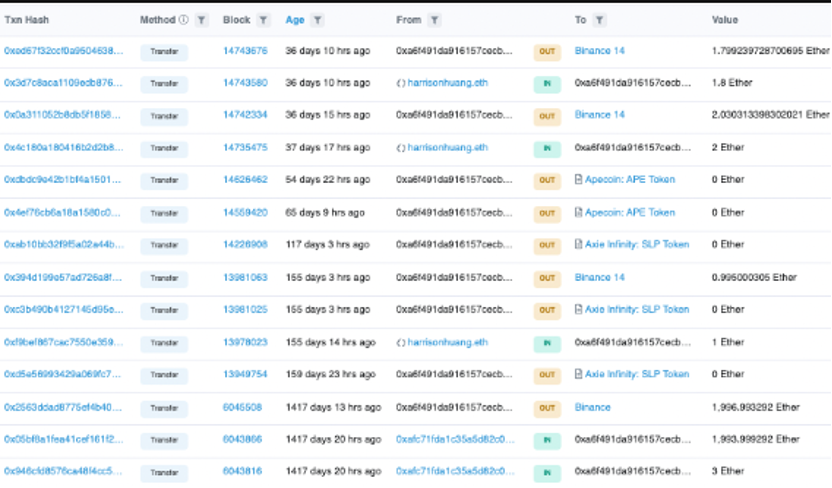
 Wilson gifted Harrison an NFT
Wilson gifted Harrison an NFT
 And Harrison gifted MAYC to Wilson
And Harrison gifted MAYC to Wilson
a) A quick search on Twitter for harrisonhuang.eth can lead to speculation about his Twitter account based on his ENS address posted on Twitter and his replies to Wilson.

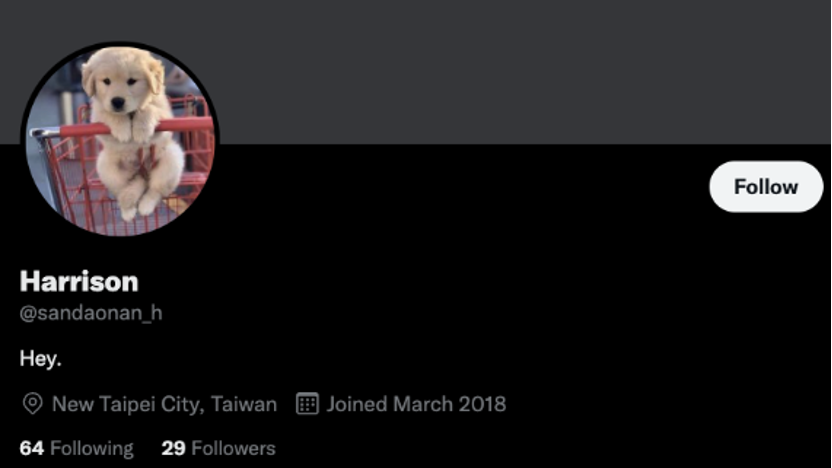
Harrison is not publicly listed as a team member on Formosa Financial's whitepaper or website. Here again, we see a personal account with no public connection to Formosa receiving project funds.
The remaining Binance accounts that received funds from Huang are stagnant: these accounts have not interacted with any other external or personal addresses recently, and transactions are merely movements between CEXs.
On July 26, 2018, Huang and Mithril were caught attempting to manipulate Binance's monthly community coin vote. Evidence discovered by a user named Lucky showed that Mithril received over 80,000 votes, almost all from two to three addresses. The principle of community coin voting is that 1 BNB equals 1 vote, and each account has a maximum voting limit of 500 BNB, meaning a voter holding 500 BNB can get the maximum of 500 votes. However, Binance stated in the rules that creating fake accounts is equivalent to mass distributing BNB, and violators will lose their eligibility to compete.

At that time, Huang was still using the same address as during the Formosa ICO, which was closely related to Mithril and held $8.6 million worth of MITH. The following image shows that many accounts that transferred large amounts of BNB at that time received fees from the largest Mithril whale wallet.
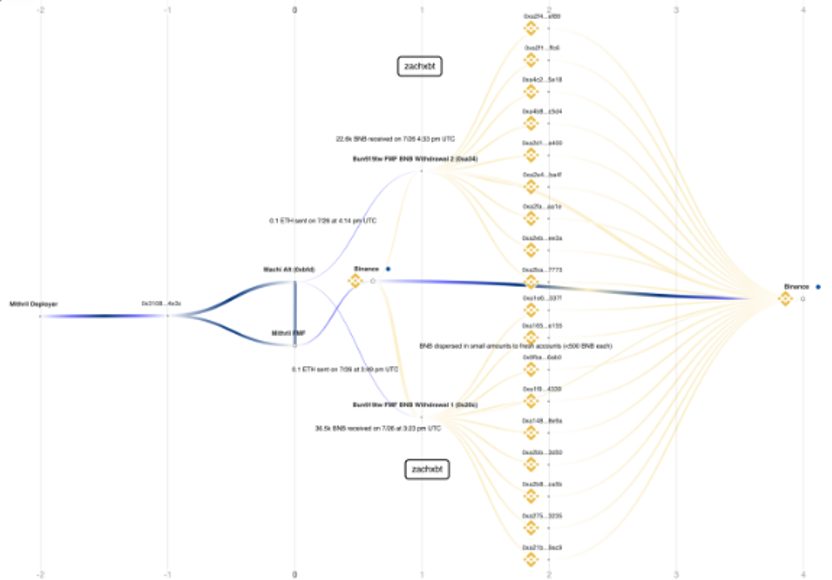
https://www.breadcrumbs.app/reports/1994
Even more shockingly, the large transfers of BNB used for vote manipulation coincided with the day Bun Hsu received 1,980 ETH, which was deposited into his Binance account less than an hour before the voting.
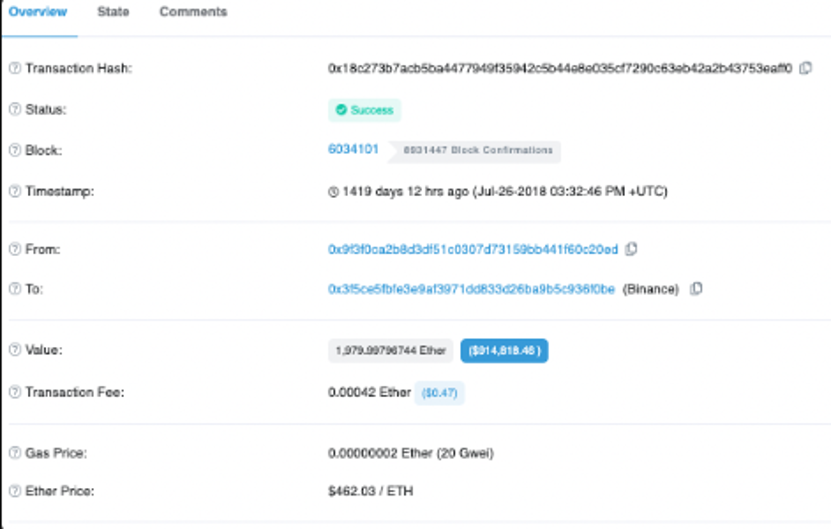
Upon examining on-chain transactions, even more BNB was distributed in amounts less than 500 to other Binance accounts, with timelines matching the theft of FMF funds.
1a) At 3:25 AM on July 28, Bun Hsu's Binance account received a transfer of 2,000 ETH.
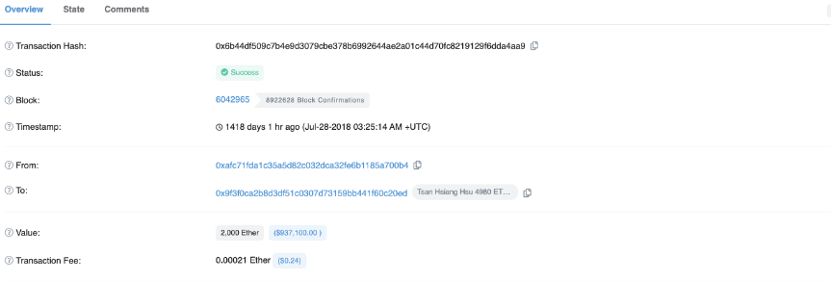
1b) At 4:43 AM (UTC) on July 28, the Binance account transferred out 43.8k BNB (estimated to also be Bun's doing).
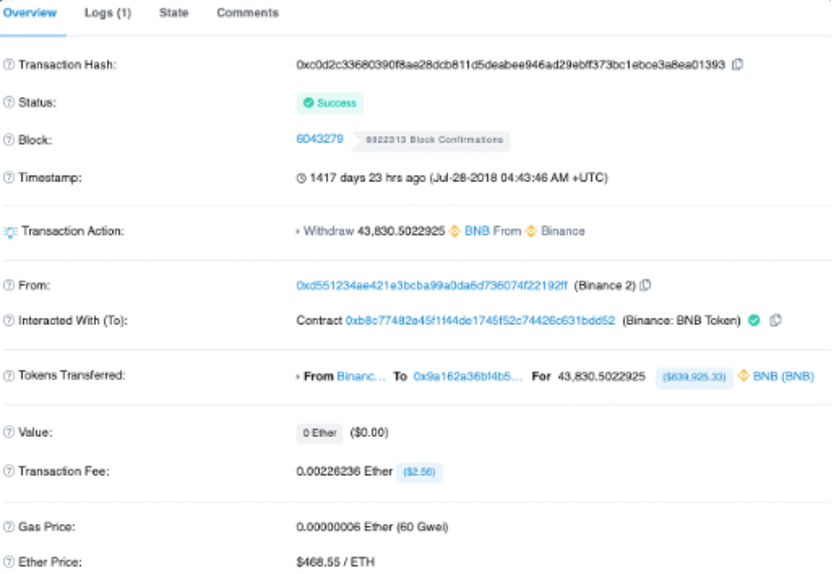
2a) Harrison Huang's Binance account deposited 1,994 ETH at 7:08 AM on July 28.

2b) At 7:28 AM on July 28, 30k BNB was withdrawn from the Binance account.
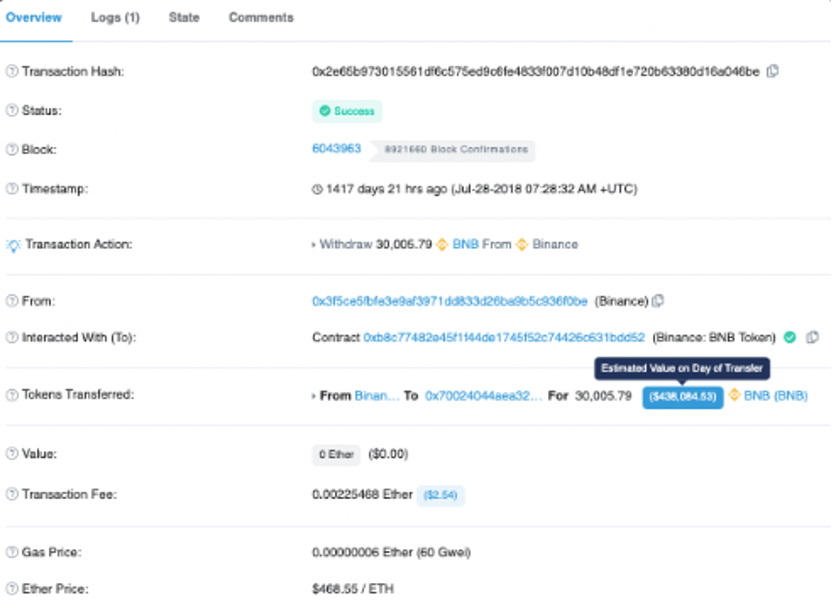
In summary, connecting these addresses and Huang with Mithril may reveal the final destination of Formosa Financial's substantial funds.
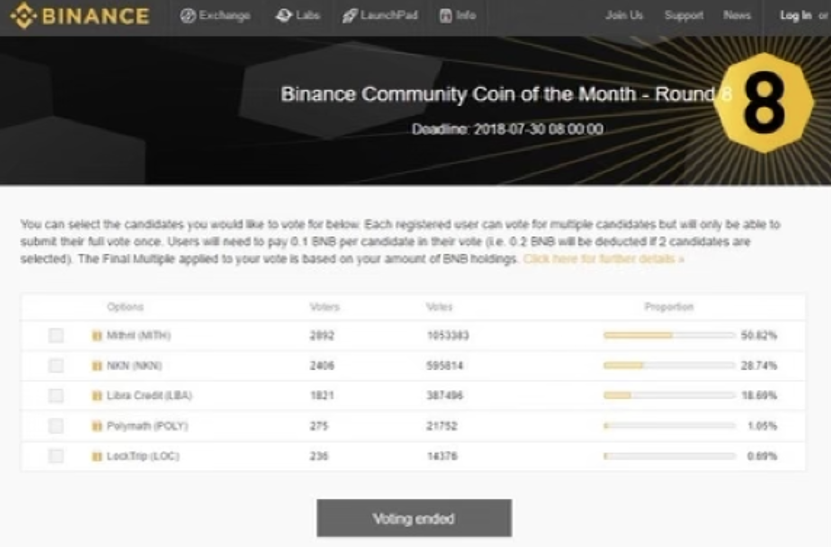
Mithril "won" the vote
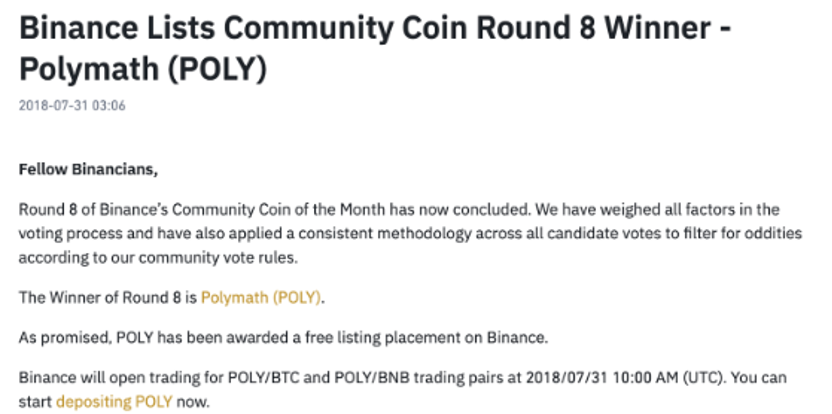
POLY won after Binance "cleaned house"
Again, it is emphasized that this may be the purpose of Formosa's fundraising.
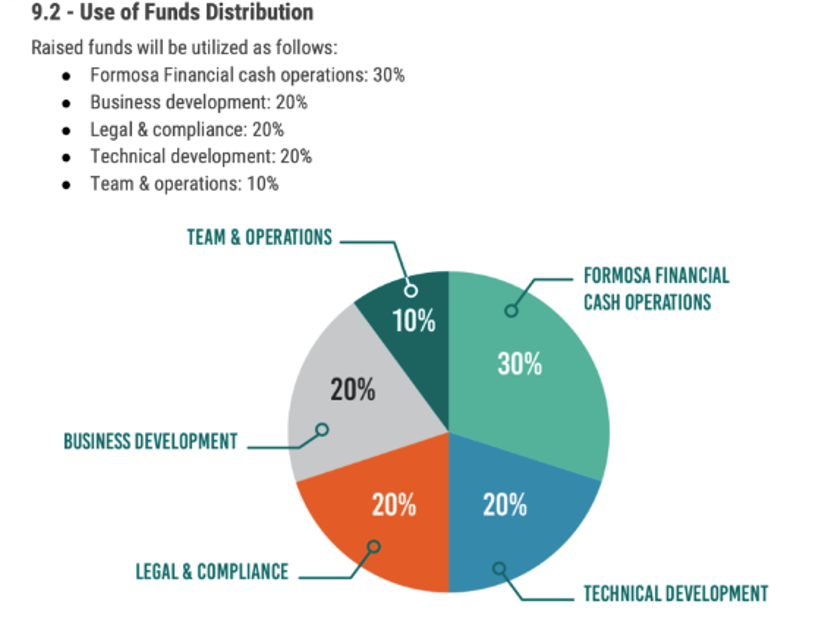

In the fall of 2018, as investors became increasingly distant from Huang, Czhang, and other key FMF team members, with no one providing proper explanations or project updates, suspicions began to arise. FMF continued to plummet, and the sudden abandonment of key team members further plunged the project into crisis.
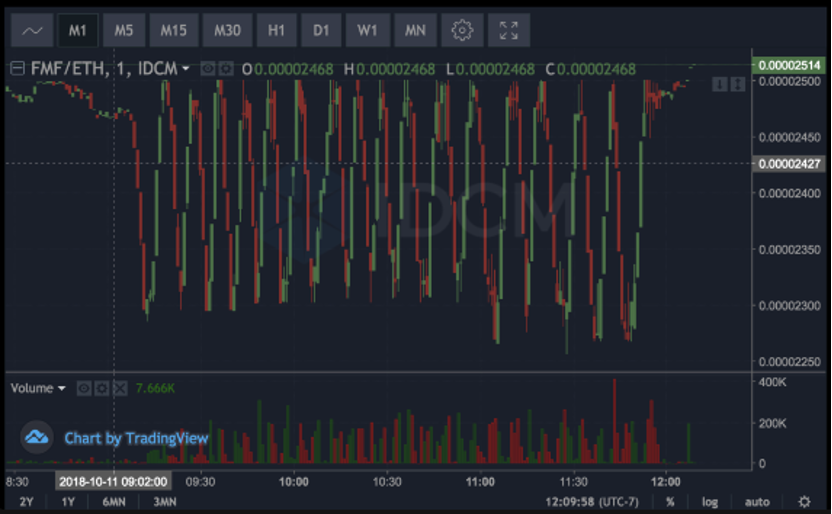
Crazy wash trading records on IDCM

Project 3: Machi X
In October 2018, Huang and Leo Cheng launched the intellectual property social marketplace Machi X. However, due to the poor performance of the previous project Mithril and the Formosa incident, his reputation plummeted, making it difficult for Machi X to secure funding.
It wasn't until more than a year after the Formosa incident that investors finally learned what had happened to their funds. On August 12, 2019, Formosa investors received an anonymous email containing internal documents as evidence, claiming that just three weeks after the 2018 ICO ended, 22,000/44,000 ETH was stolen from the private sale wallet of Formosa Financial. The email included various internal documents to support this claim.
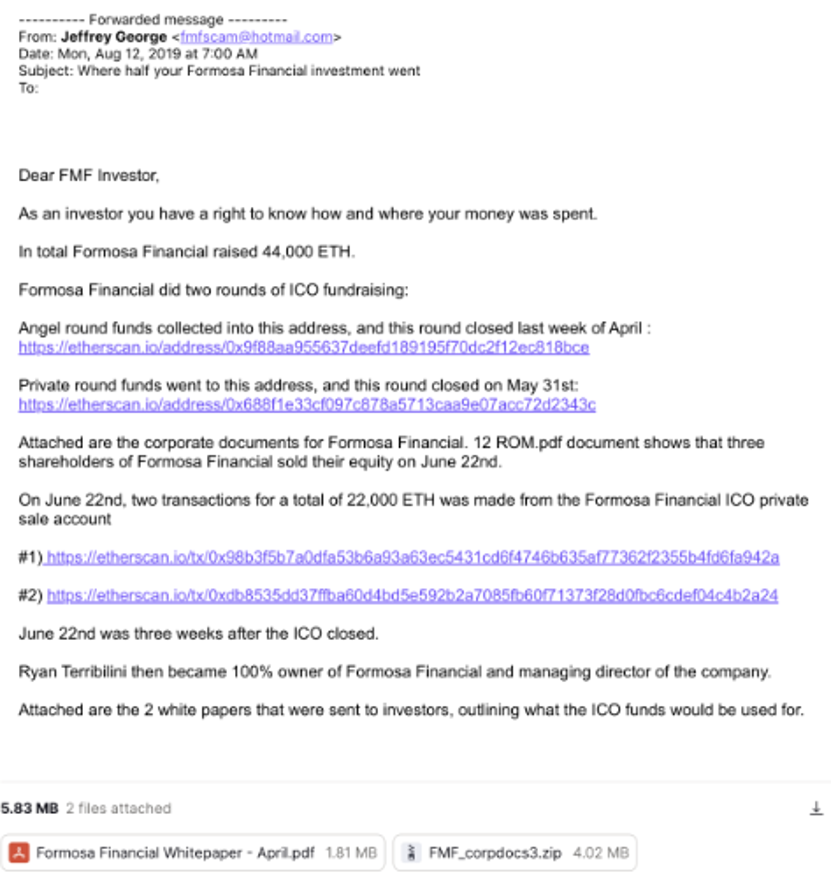
In a leaked audio from 2019, former CEO of Formosa Ryan Terribilini shared his views on the funds misappropriated by Huang and George, as well as the subsequent events.
Regarding why no legal action was taken against Huang and George at the time, several venture capital firms and angel investors that invested in the project stated that Huang and George were prominent figures in Taiwan, and the incident occurred across multiple jurisdictions, leading investors to agree to handle the matter simply to avoid unnecessary trouble.
Project 4: Cream Finance
In 2020, the cryptocurrency market began to heat up again. Huang dismantled the decentralized peer-to-peer lending platform Compound Finance and, in early July 2020, established Cream Finance with Leo Cheng. Bun Hsu, Jeremy Yang, and Stanley Yang were also part of Cream's development team. As of today, Cream Finance has been exploited three times for more than $192 million USD due to negligence.
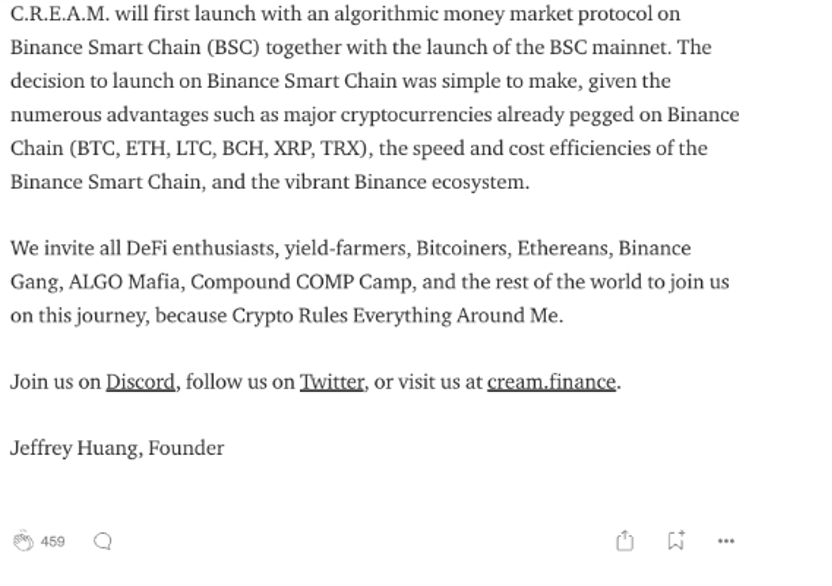
Translator's note: The original text here is missing (or deleted?) Project 5
Project 6: Swag Finance
Swag Finance is an adult entertainment website founded by Machi. It launched its governance token in early October 2020. When Swag was quietly listed as collateral for Cream Finance, the lack of transparency surrounding the listing sparked significant controversy on Twitter, as the token underwent a "cultivation to abandonment" process within weeks, ultimately delisting from Cream.
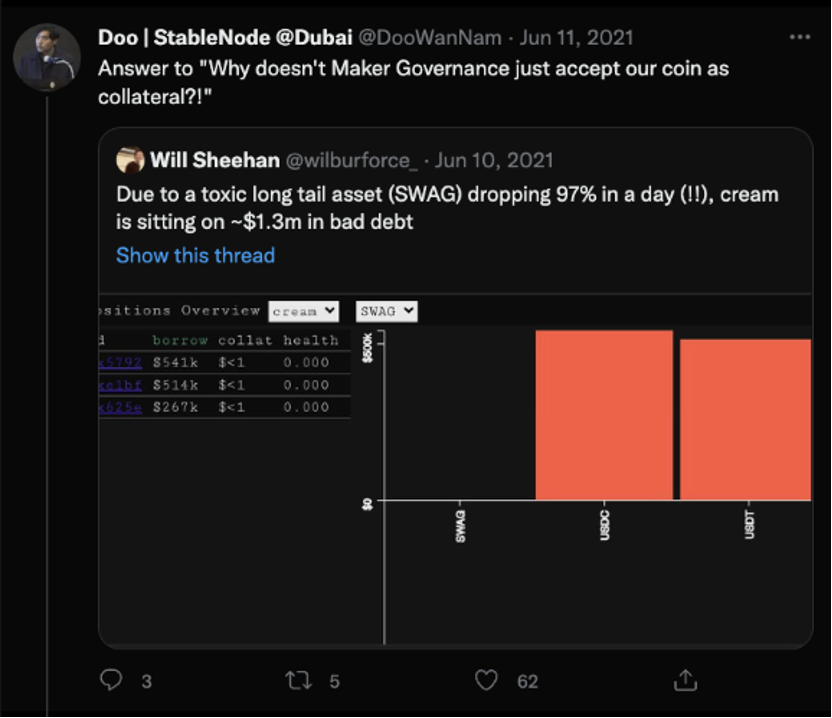
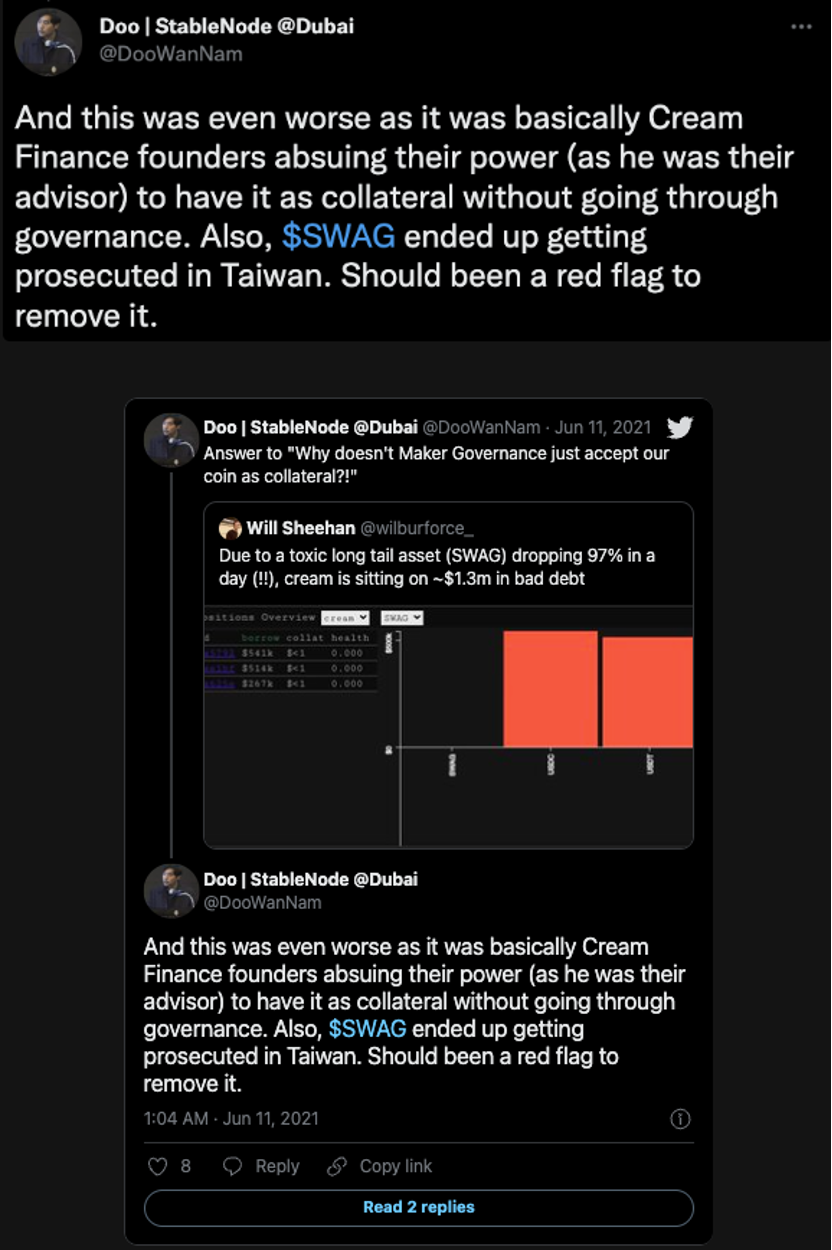
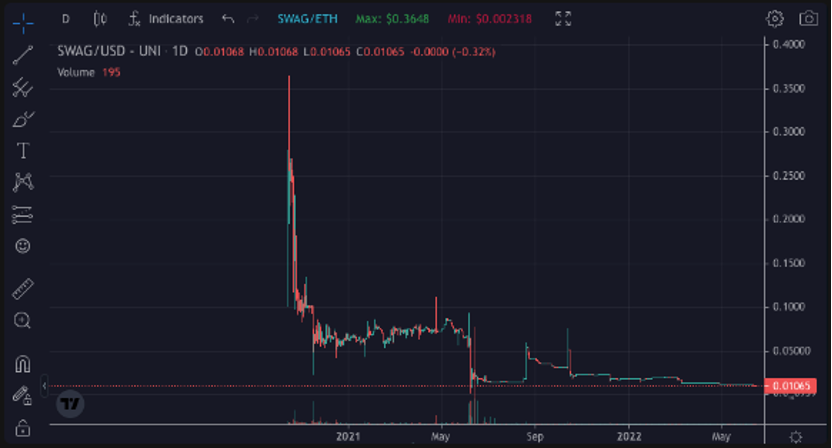
https://www.dextools.io/app/ether/pair-explorer/0x2059024d050cdafe4e4850596ff1490cfc40c7bd

One and a half months after the token release, Swag delisted from Cream.
Project 7: Mith Cash
On December 30, 2020, Huang and Mithril returned with a new project, Mith Cash, a branch of the Basis Cash protocol (an algorithmic stablecoin). Within just a few days after its launch, Mith Cash's TVL grew to $1 billion, only to rapidly collapse as investors redeemed rewards. Mith Cash ultimately met the same fate as Basis Cash. Similar to Huang's other projects, the project team was also so-called "anonymous," and Huang claimed to be "just an advisor."
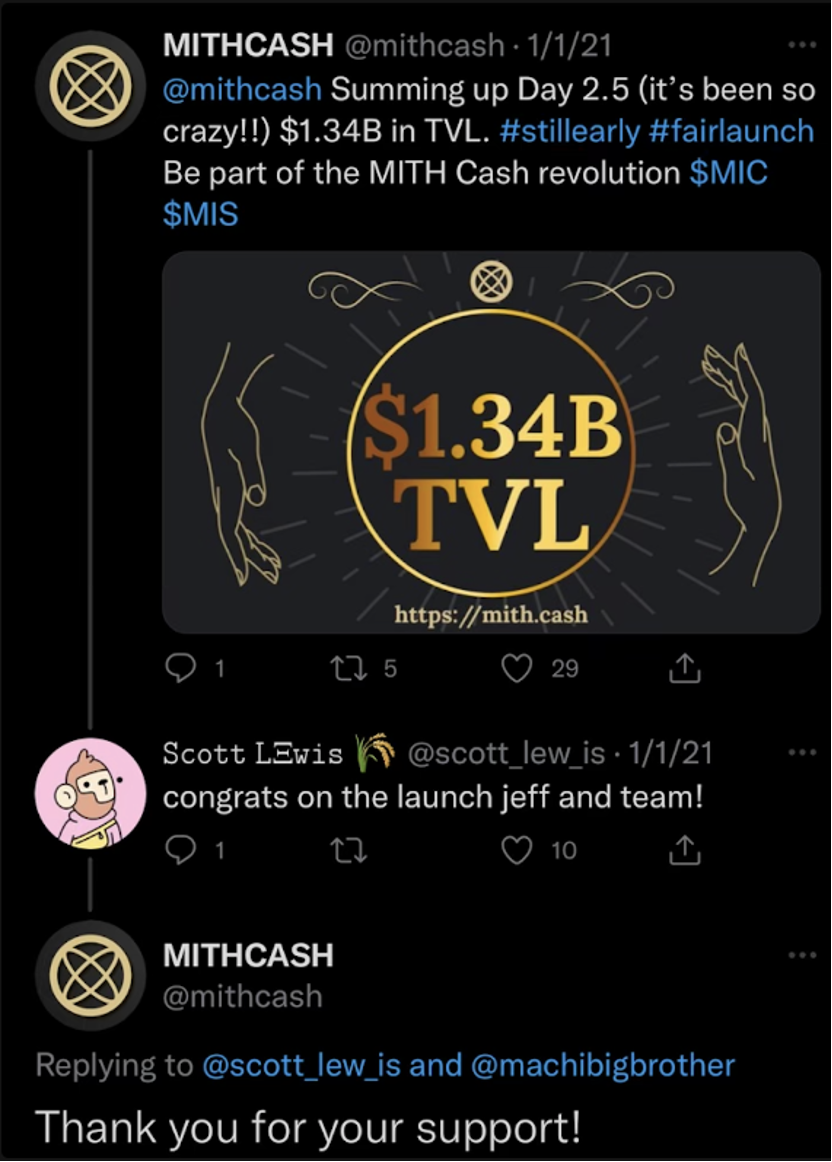
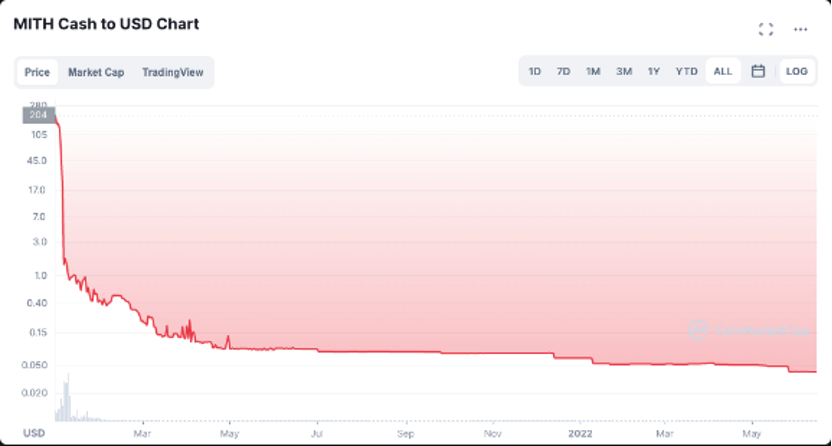
https://coinmarketcap.com/currencies/mith-cash/
Project 8: Typhoon Cash
Shortly after the collapse of Mith Cash, Machi returned again in the form of Typhoon Cash (a branch of Tornado Cash). The team claimed to have a "secret force," but it seemed widely known that Huang and his friends were the masterminds behind this team. From the various signs at the launch, calling this project a "rug pull" would be an understatement ------ anyone could invest in the anonymous pool and remain anonymous; however, to receive rewards, one had to invest in the anonymous pool. This meant that to receive rewards, the deposited rewards would be disclosed, rendering the concept of anonymous coins worthless. The project was abandoned just weeks after its launch, leaving the mess to the staff of Telegram and Discord channels.
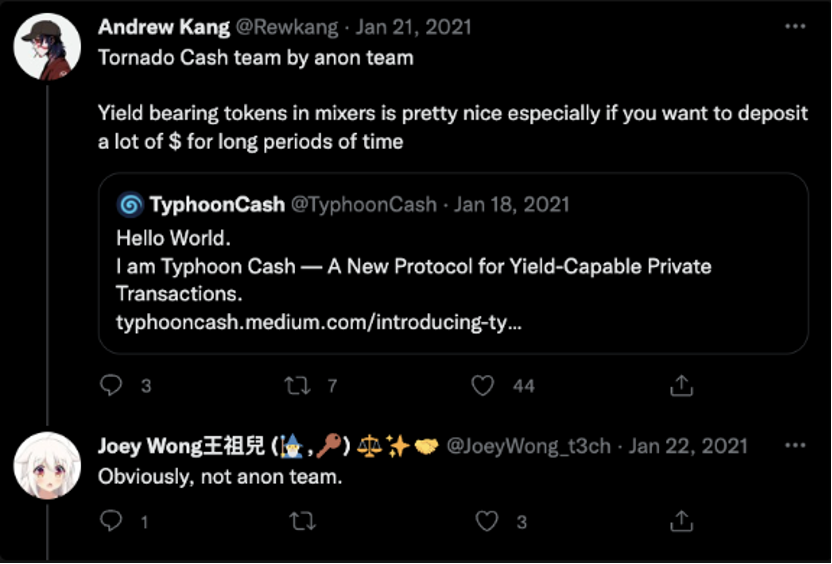
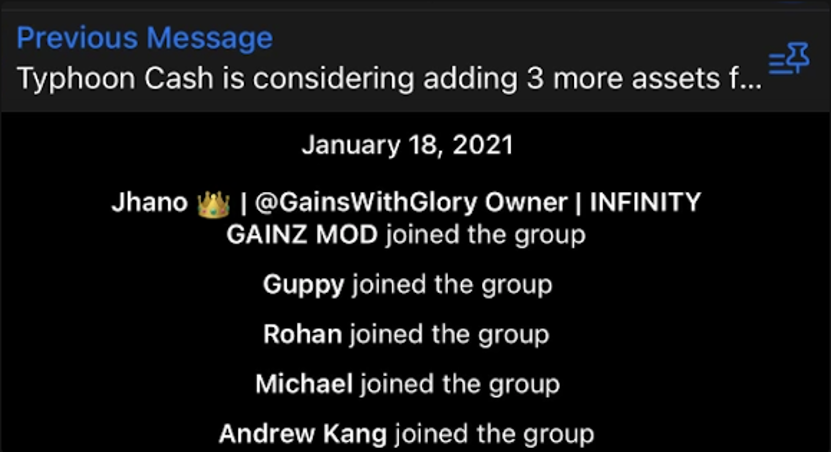
Rewkang was one of the top five members on Telegram.
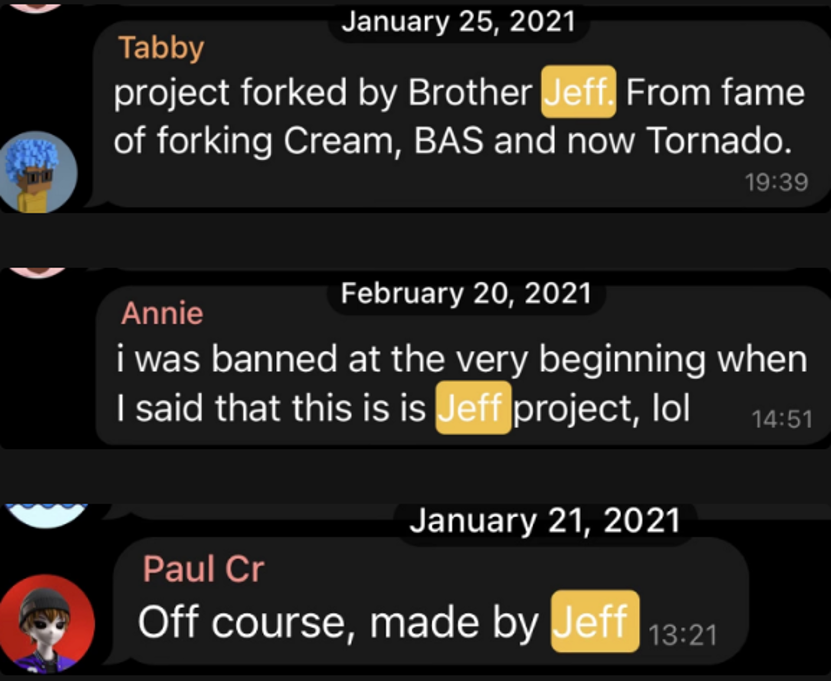
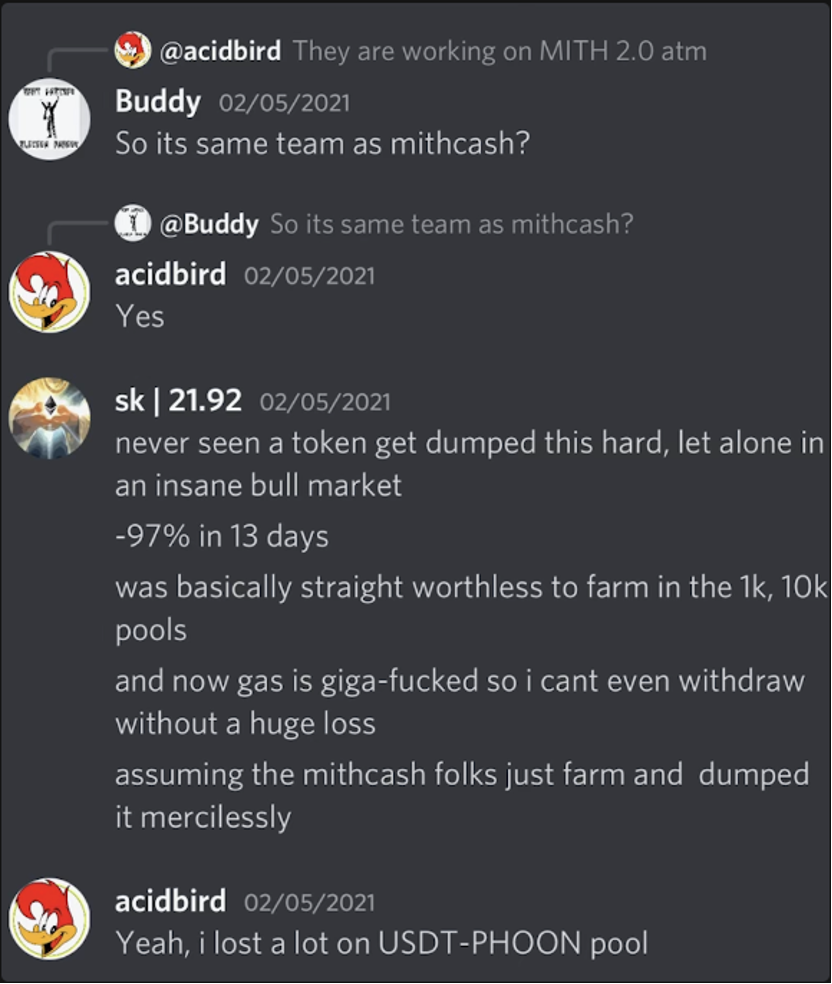
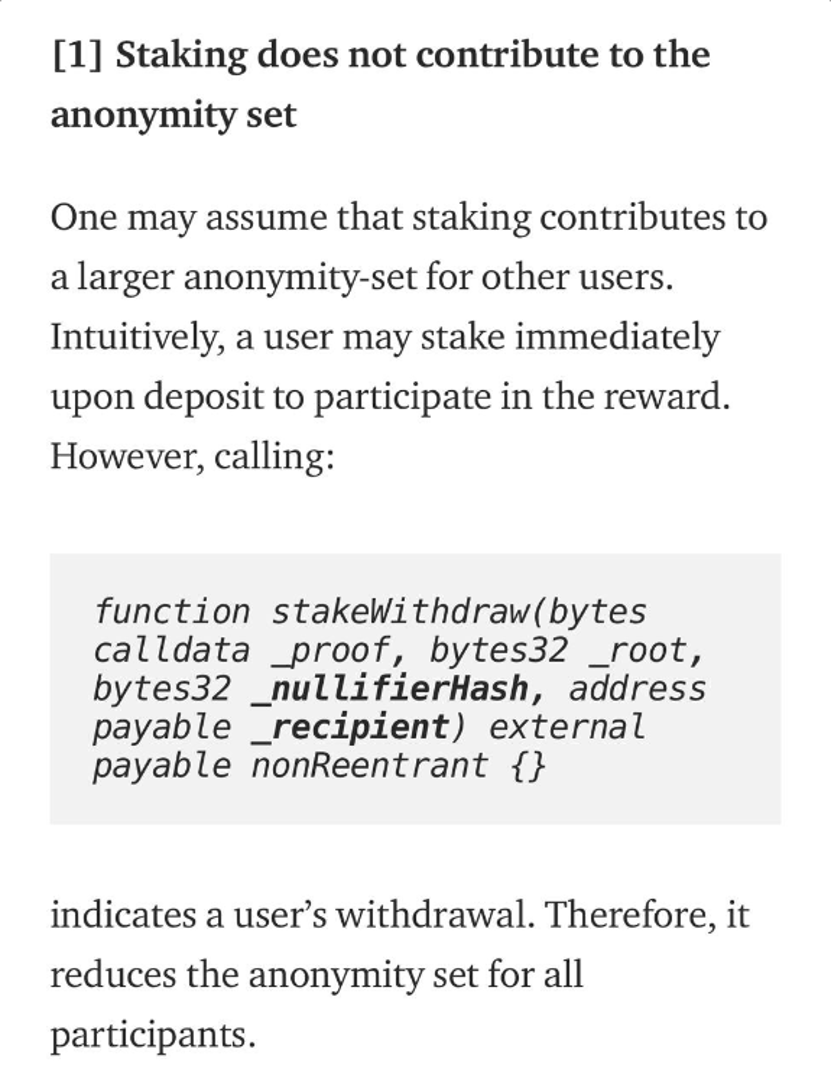
The vulnerabilities of Typhoon Cash were disclosed by Avner and verified by Nick.
For example:

https://etherscan.io/tx/0x8b8e68ed2e323be4c13e8a973817af55ebe7c6a9d5ce877dee580374aa0d7233
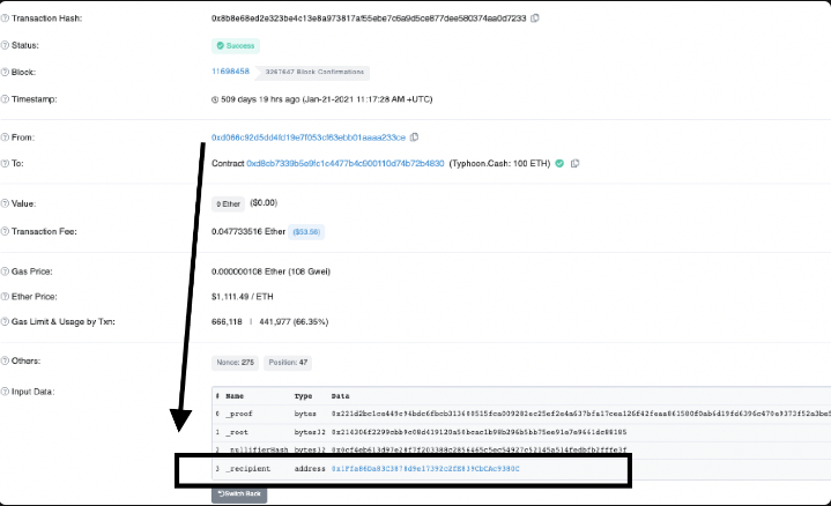
Withdrawal address below "Recipient"
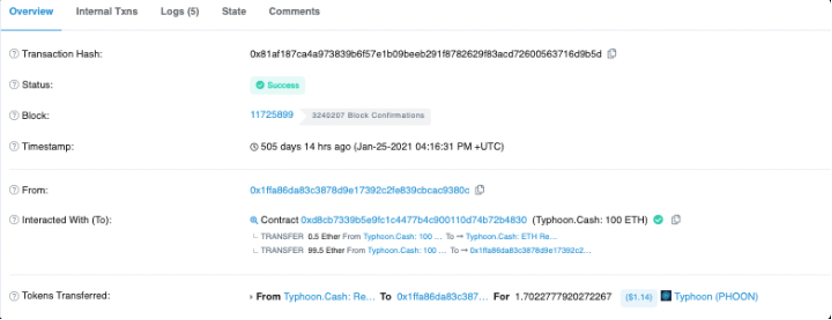
The second address unstaked and exited
Since February 2021, no further misleading updates have been posted on Discord, Telegram, or Twitter.
Project 9: Mud Games
With the sudden popularity of the on-chain random game asset Loot for Adventurers at the end of August 2021, the quick-witted Machi immediately launched his version called Heroes of Evermore, which quickly earned a profit of 533.92 ETH for the "anonymous team." Unlike Loot, Heroes of Evermore was not randomly generated; the team members had secretly minted the rarest NFTs from the collection while keeping holders in the dark.

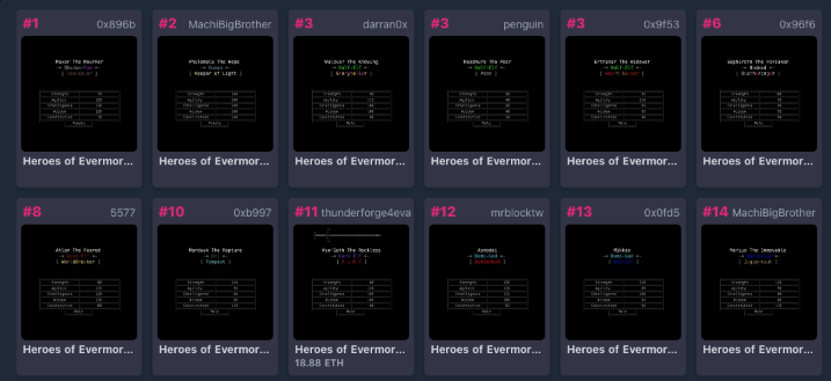
Team members Huang and penguin minted #2 and #3.
Project 10: Squid DAO
In October 2021, another "anonymous team" established a replica of OHM/Nouns DAO called Squid DAO. MachiBigBrother.eth was one of its early holders, and by January 2022, the project was shut down at Machi's behest.

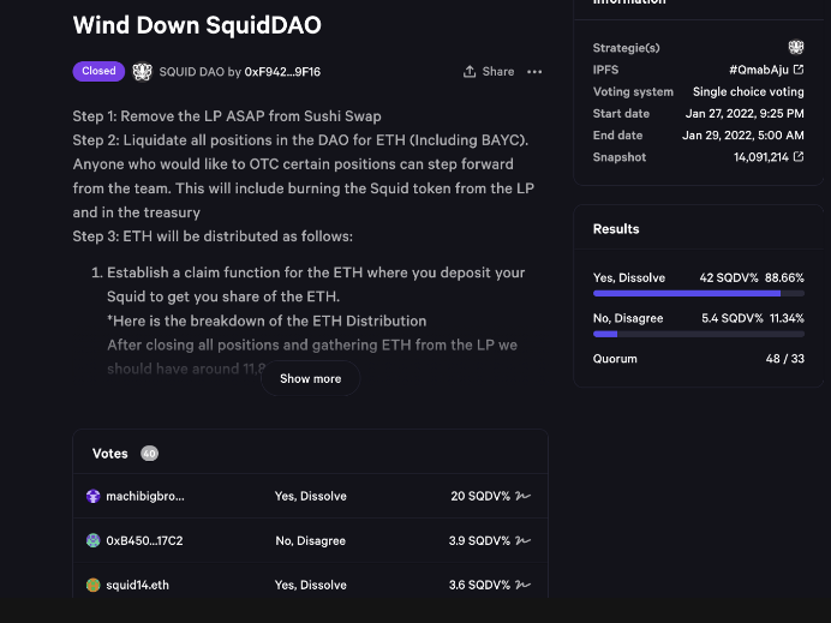 https://vote.squid.xyz/#/
https://vote.squid.xyz/#/
Today, Machi has turned to X, XY Finance, and his latest work: Ape Finance.
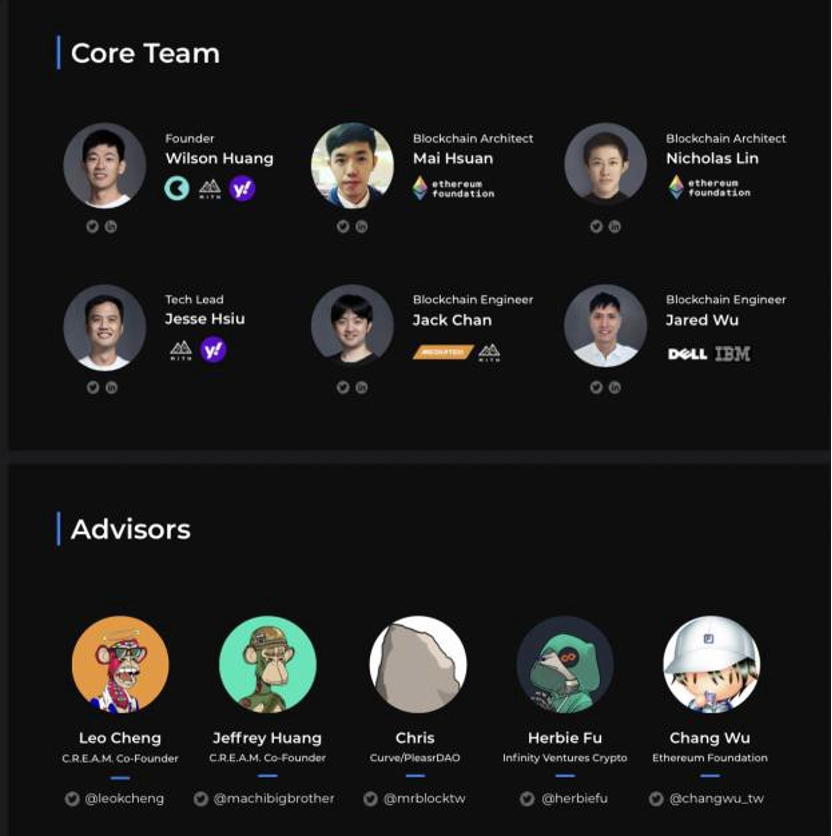
The team and advisors of XY Finance
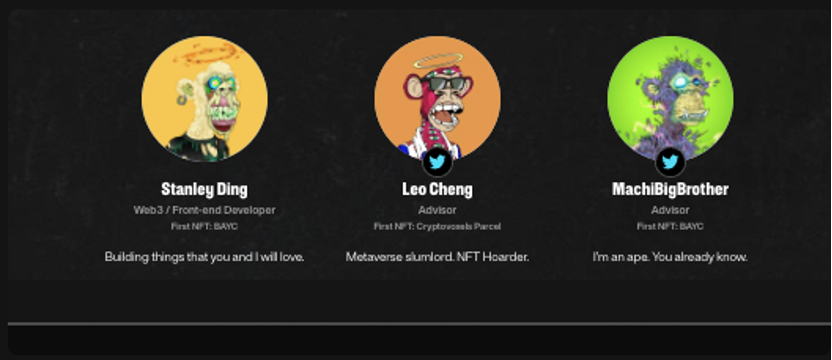 X advisor
X advisor
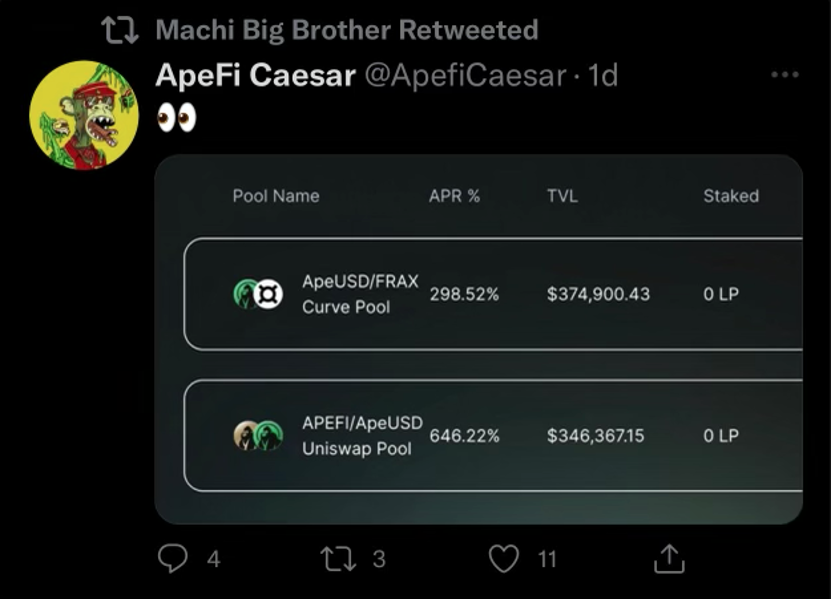
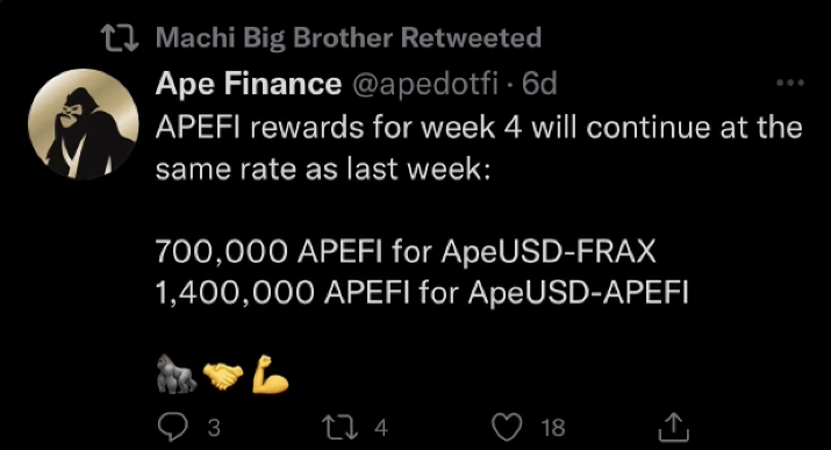
Ape Finance
In Huang's many projects, the same keywords always appear: anonymous teams, replica projects, new wallets funded through FTX, and short lifespans. The participants in each project are also the same: Wilson, Leo, and Huang. As for why VCs like Andrew Kang turn a blind eye to this matter, he stated:
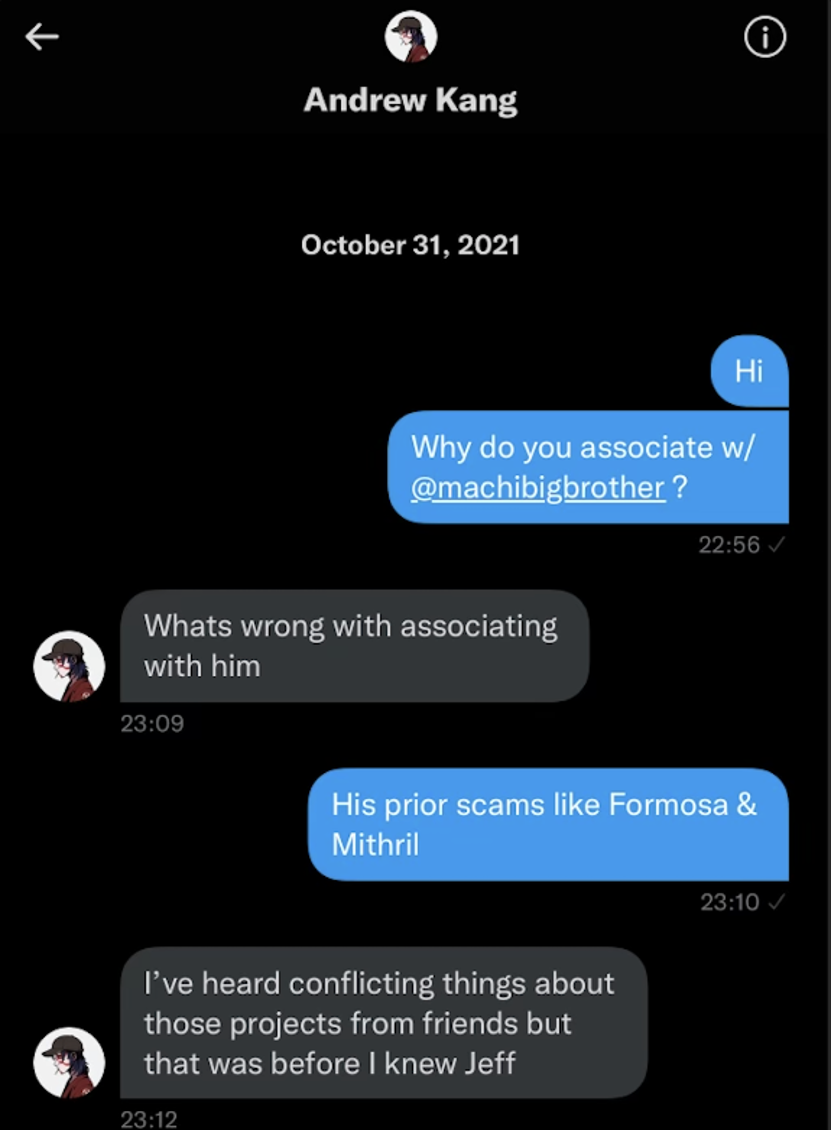
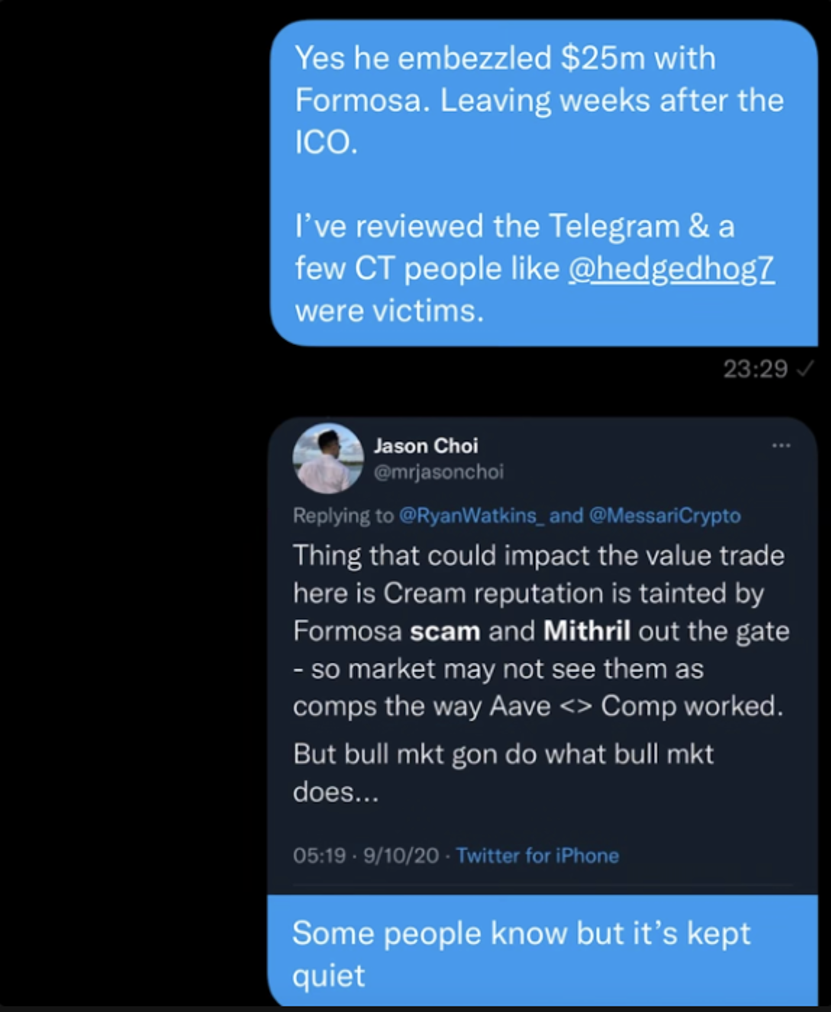

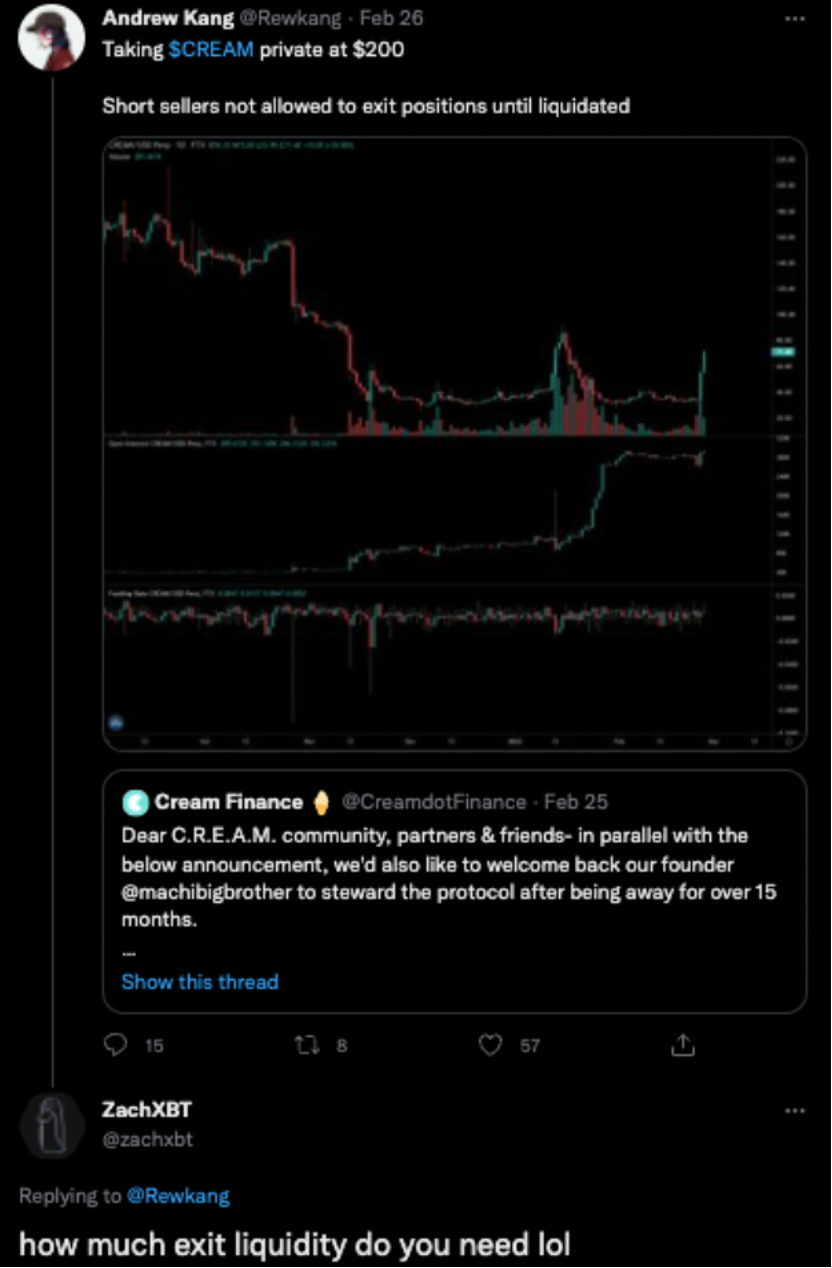
Even in February, when Cream Finance was on the verge of collapse, Andrew helped Huang again. When it comes to money, it is truly sad to turn a blind eye to one's actions that cause significant financial losses to others, whether it is helping to launch more than a dozen unwise projects or aiding in the misappropriation of 22,000 ETH.
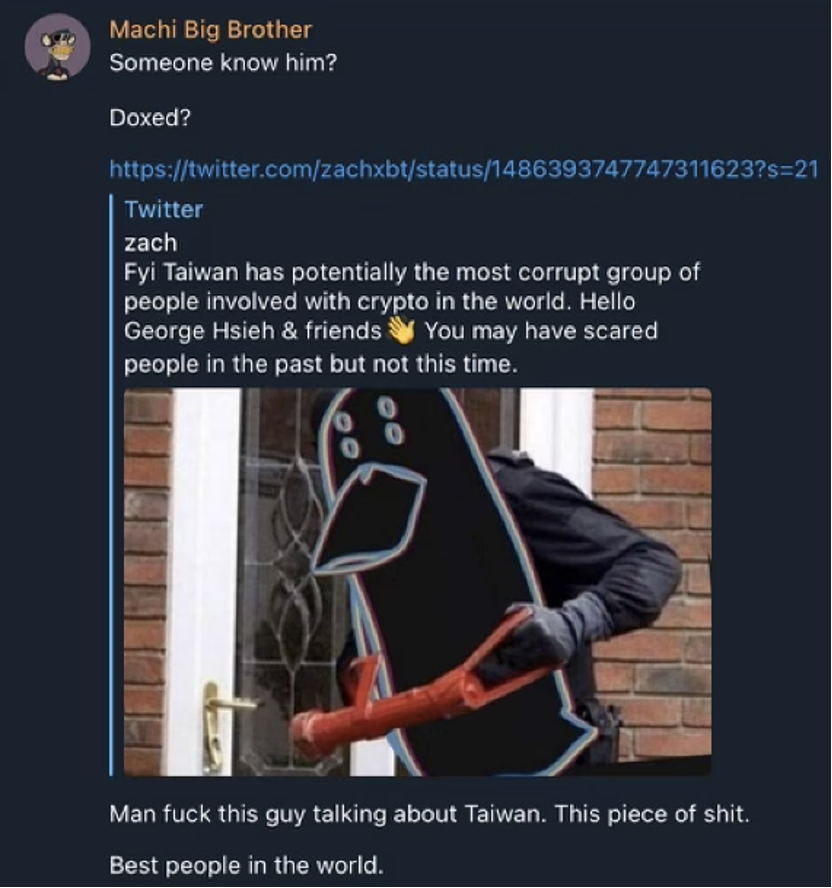
Message from pleasrDAO Telegram
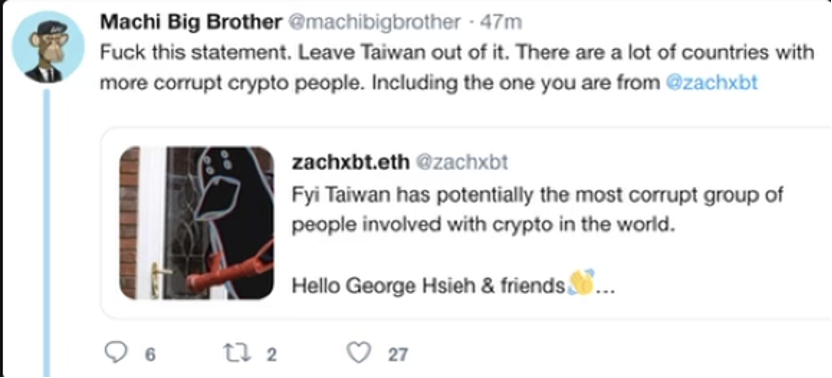
After the wrongdoing was made public, Huang responded to the negative impact on Taiwan, yet he and his "anonymous team" continue to bring shame to Taiwan and the crypto space. It is hoped that one day, all those who suffered losses due to Huang's projects will see justice served.










